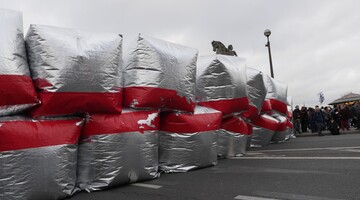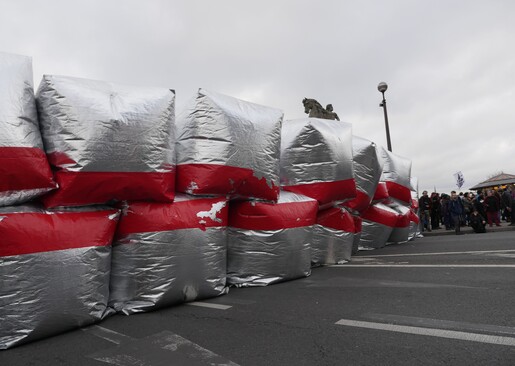
MQ: Exhibition Overground Resistance at frei_raum Q21 exhibition space
Forests are burning, permafrost soils are thawing, polar ice and glaciers melt, drought strikes once fertile regions, plant and animal species are becoming extinct on a massive scale. Yet even as the impact of climate breakdown comes to be felt everywhere, government climate policy worldwide is woefully inadequate to the urgency of the crisis. On one day, states declare a climate emergency; the next day they still sponsor fossil-fueled energy, building freeways, airports and gas pipelines, enclosing territory on whatever scale the projects demand. The exhibition “Overground Resistance” (26.08. – 21.11.), curated by Oliver Ressler, brings together artists who produce their works in dialogue with the climate justice movements in which they consider themselves participants. The exhibition opening takes place on the 25th of August at 7pm. There will be a guided tour for the press at 10am.
The past 25 years of UN climate negotiation have led to no reduction of global carbon emissions whatsoever. Meanwhile, extra-parliamentary and horizontally organized social movements have never relented in their pressure on states to end the fossil fuel economy outright and ensure swift transition to a carbon-neutral society.
Modes of transport, food production as well as labor must be reorganized and the overall social focus shifted from growth and profit towards resource conservation, preservation of livelihoods, climate justice and global redistribution, for example by means of drastically increased taxation of climate-destructive modes of transport and forms of production that squander resources.
Historically, resistance has often been organized “underground” by partisans or extra-parliamentary groups. Climate activism, by contrast, is coming “overground” on a massive scale, despite often crossing the boundaries of what is considered “legal”. The worldwide scope and visibility of the movement reflect the terrifying global scale of the threat and also the unprecedented social breadth and depth of collective determination to counteract it.
Thus, the movements’ blockade of German lignite mines played a crucial part in the decision of that country’s government to phase out the use of coal. (The prevailing view among climate scientists, however, is that the projected exit date of 2038 is too late to allow Germany to meet its binding commitments under the Paris climate Agreement.) Were it not for the years of implacable pressure from Indigenous American Water Protectors, US President Joe Biden would likely never have revoked Federal approval of the Keystone XL tar sands oil pipeline.
Millions of people determined to prevent total planetary climate collapse – to preserve the Earth as habitat for future generations – are joining the climate justice movement and collectively taking action. This is also true of many artists.
The exhibition brings together artists who produce their works in dialogue with the climate justice movements in which they consider themselves participants.
The range of strategies and approaches here is remarkable. To mention only a few examples:
The Natural History Museum is a mobile pop-up-museum founded in 2014 by the Not an Alternative collective, whose campaigns are often undertaken conjointly with Indigenous activists or under-represented communities. One focus (among others) is oil industry sponsorship and its role in deciding what is shown in museums, how those works are presented, and what will be excluded altogether.
Jay Jordan and Isabelle Frémeaux of the Laboratory of Insurrectionary Imagination organized the “Climate Games” event during the Paris COP21 conference of December 2015. The forms of action developed shaped the climate justice movement’s appearance. In a film shown in the exhibition, Jay Jordan describes artists’ role as one of involvement in the social movements that also constitute their material. Boundaries between art and activism dissolve altogether in this practice.
The film “Notre Flamme Des Landes: The Illegal Lighthouse Against an Airport and its World” (2018) focuses on the ZAD autonomous zone, which was formed during resistance to an airport development project near Nantes, France, and is now where Jordan and Frémeaux live.
Tiago de Aragão produces films as a participant in the struggles of Indigenous communities in Brazil against the destruction of their livelihoods, such as “Entre Parentes” (2018) about the indigenous protest camp Acampamento Terra Livre in Brasilia.
In their film “Rise: From One Island to Another” (2018) Aka Niviâna and Kathy Jetnil-Kijiner show the mutual dependence of their respective home territories Greenland and the Marshall Islands, in both of which melting ice floes and the rising sea levels resulting constitute immediate reality.
Rachel Schragis, a community organizer and coordinator of climate activism in Brooklyn, NYC, vividly conveys insights obtained through this engagement in her large-format flowchart “Confronting the Climate” (2016). This work emerged from her organizing activity for the New York “People's Climate March” of 2014.
The provocative text-based work “Artists Must Create on the Same Scale that Society Has the Capacity to Destroy” by Lauren Bon and the Metabolic Studio confirms once and for all that nothing in this exhibition is a matter depiction or documentation in a pure sense. Rather, it is all about establishing relationships with social movements in which the artists and cultural producers are actively engaged.
A number of exhibitions within the last few years have addressed climate breakdown.
The exhibition at the frei_raum Q21 exhibition space, by contrast, appears to be the first art exhibition worldwide to focus directly on climate activism.
The exhibition “Overground Resistance” can be considered an extension of Oliver Ressler’s research project “Barricading the Ice Sheets” (funded by the FWF), in which the artist investigates the climate crisis and the climate justice movement in relation to art. “Barricading the Ice Sheets” is comprised of solo exhibitions at Camera Austria, Graz (04. 09. – 21. 11. 2021 ); Museum of Contemporary Art, Zagreb ( 30. 11. 2021 – 30. 01. 2022 ); Neuer Berliner Kunstverein (n.b.k.), Berlin (June – August 2022); Tallinn Art Hall, Tallinn (09. 09. – 13. 11.2022); The Showroom, London (October – December 2022).
The accompanying programme to the exhibition will include a film evening as part of this year's film festival frame[o]ut, as well as several artists' talks.
Artists:
Tiago de Aragão (BRA), Lauren Bon and the Metabolic Studio (USA), Noel Douglas (GBR), Francisco Huichaqueo (Mapuche Nation/CHL), Gilbert Kills Pretty Enemy III (Hunkpapa Lakota of the Standing Rock Sioux Tribe/USA), Kathy Jetn̄il-Kijiner & Aka Niviâna (MHL/GRL), Laboratory of Insurrectionary Imagination (FRA), The Natural History Museum (USA), Oliver Ressler (AUT), Rachel Schragis (USA), Seday (FRA), Jonas Staal (NLD), Tools for Action (HUN/NLD)
Curator: Oliver Ressler
“Overground Resistance” is organised in cooperation with the Federal Ministry for European and International Affairs. The exhibition will be continued in a new configuration at NeMe Arts Centre, Limassol, Cyprus in 2022.
Exhibition display: Magdalena Hofer, student at the department for stage- and costume design, film- and exhibition architecture, Mozarteum University Salzburg
Overground Resistance
26.08. – 21.11., Tue-Sun 13-16h & 16.30-20h, free admission
Opening: Wed 25.08., 19h
Guided tour for the press: Wed 25.08., 10h
Location: frei_raum Q21 exhibition space/MuseumsQuartier Vienna
www.Q21.at
Director MuseumsQuartier Wien: Christian Strasser

